History
The Olympus OM-3 is a manual camera without automatic exposure modes, and an entirely mechanical shutter. Introduced in 1983, the OM-3 was the first of a new series of professional camera bodies designed to update the OM-1 and OM-2. These new bodies, which continued with the more popular OM-4, included a number of refinements over their predecessors. The most significant changes made were to the metering system. The OM-3 and OM-4 featured multi-spot metering in addition to the centre-weighted metering on the earlier bodies. This allowed the user to take a number of spot meter readings, all of which were used by the camera to calculate the correct exposure. The system also featured "highlight" and "shadow" buttons which allowed the photographer to identify parts of a scene that should be exposed as white or black respectively. The metering system used a liquid crystal display in place of the older match needle design of the OM-1 and OM-2.
Other refinements were also present, including a faster maximum shutter speed of 1/2000 second and a built in flash hot shoe.
The OM-3 sold in smaller quantities than its electronic sister, the OM-4. This may be because the OM-1n remained in production and offered an alternative mechanical body for the OM system at a fraction of the price, albeit with less sophisticated metering. After a relatively short production run, the OM-3 was discontinued in 1986. As a result, OM-3 bodies today are much rarer than OM-4s, and those in good condition are highly sought after by collectors.
In 1995, the OM-3Ti was released, an improvement of the OM-3, which was in production until 2002.
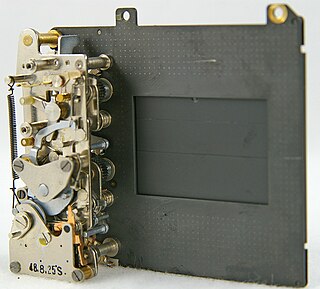
In camera design, a focal-plane shutter (FPS) is a type of photographic shutter that is positioned immediately in front of the focal plane of the camera, that is, right in front of the photographic film or image sensor.

The Nikon FM is a mechanically operated, interchangeable lens, 35 mm film, single-lens reflex (SLR) camera. It was manufactured in Japan between 1977 and 1982 by Nippon Kogaku K. K..

The Olympus E-1, introduced in 2003, was the first DSLR system camera designed from the ground up for digital photography This contrasts with its contemporaries which offered systems based on reused parts from previous 135 film systems, modified to fit with a sensor size of APS-C.

The Nikon FA was an advanced amateur-level, interchangeable lens, 35 mm film, single-lens reflex (SLR) camera. It was manufactured by the Japanese optics company Nippon Kogaku K. K. in Japan from 1983 to 1987. The FA used a titanium-bladed, vertical-travel Nikon-designed, Copal-made focal plane shutter with a speed range of 1 to 1/4000th second plus Bulb and flash X-sync of 1/250th second. It was available in two colors: black with chrome trim and all black. The introductory US list price for the chrome body only was $646. Note that SLRs usually sold for 30 to 40 percent below list price.

The Nikon FG is an interchangeable lens, 35 mm film, single-lens reflex (SLR) camera. It was manufactured by Nippon Kogaku K. K. in Japan from 1982 to 1986.

The Canon EF is a manual focus 35mm single-lens reflex camera produced by Canon between 1973 and 1978. It was compatible with Canon's FD-mount lenses. The EF was built as an electro-mechanical version of Canon's top-of-the line wholly mechanical Canon F-1. The shutter is mechanical at all speeds starting at 1 second and faster, but from 2 seconds and beyond the shutter is all electric, allowing for AE shutter speeds as long as 30 seconds. The EF shares the F-1's rugged construction and tough metal body. Unlike the F-1, the EF does not support any motor drive for film transport. Neither does it provide any interchangeable viewfinder.
In photography, through-the-lens metering refers to a feature of cameras whereby the intensity of light reflected from the scene is measured through the lens; as opposed to using a separate metering window or external hand-held light meter. In some cameras various TTL metering modes can be selected. This information can then be used to set the optimal film or image sensor exposure, it can also be used to control the amount of light emitted by a flash unit connected to the camera.
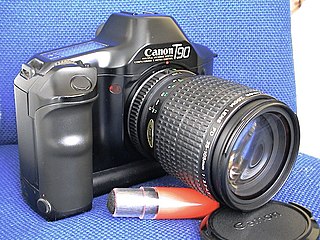
The Canon T90, introduced in 1986, was the top of the line in Canon's T series of 35 mm Single-lens reflex (SLR) cameras. It is the last professional-level manual-focus camera from Canon, and the last professional camera to use the Canon FD lens mount. Although it was overtaken by the autofocus revolution and Canon's new, incompatible EOS after only a year in production, the T90 pioneered many concepts seen in high-end Canon cameras up to the present day, particularly the user interface, industrial design, and the high level of automation.
The Olympus OM System was a line of 35mm single-lens reflex cameras, lenses and accessories sold by Olympus between 1972 and 2002. The system was introduced by Olympus in 1972. The range was designed by Yoshihisa Maitani, chief designer for Olympus, and his staff; OM stands for Olympus Maitani.

The Olympus OM-2 is a single-lens reflex film system camera produced by Olympus of Japan.

The Olympus OM-1 is a manually operated 35mm single-lens reflex camera. It is part of the Olympus OM system.

The history of the single-lens reflex camera (SLR) begins with the use of a reflex mirror in a camera obscura described in 1676, but it took a long time for the design to succeed for photographic cameras. The first patent was granted in 1861, and the first cameras were produced in 1884, but while elegantly simple in concept, they were very complex in practice. One by one these complexities were overcome as optical and mechanical technology advanced, and in the 1960s the SLR camera became the preferred design for many high-end camera formats.

The Olympus XA was a series of 35 mm cameras manufactured and marketed by Olympus of Japan. The original XA was a rangefinder camera with a fast 35 mm f/2.8 lens, and aperture priority metering. It was one of the smallest rangefinder cameras ever made, together with the Contax T. Later models—XA2, XA3 and XA4—featured scale focusing instead of rangefinders.
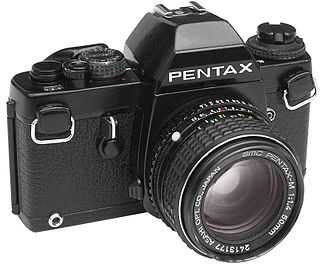
The Pentax LX is a 35mm single-lens reflex camera produced by Pentax in Japan. It was introduced in 1980 to commemorate the 60th anniversary of Asahi Optical Co., and was produced until 2001. It is the top-of-the-line professional, or "system", camera in the Pentax manual focus range, with manual and aperture priority automatic exposure modes and an advanced light metering system. The LX uses the K mount, which is the Pentax proprietary bayonet lens mount, and has a large body of accessories. The camera has several unique or uncommon features, and compared with contemporary professional camera bodies from rival manufacturers, like the Canon New F-1 or Nikon F3, the LX body is smaller and lighter, weighing in at 570 grams with its standard FA-1 finder.

The Olympus OM-4 is an interchangeable-lens, 35 mm film, single lens reflex (SLR) camera; manufactured by Olympus Optical Co., Ltd. in Japan, and sold as OM-4 from 1983 to 1987 and as OM-4Ti from 1986 to 2002.

The Pen, or PEN series is a brand of Olympus. It was used on analog half-frame compact and SLR models from 1959 until the early 1980s. In 2009, Olympus released the PEN E-P1, a digital mirrorless interchangeable-lens camera, which opened the range of Digital PEN models, which are still sold today. Olympus Corporation's camera division since has been bought by Japan Industrial Partners, and run under the OM Digital Solutions name. They continue to run the Digital PEN series.
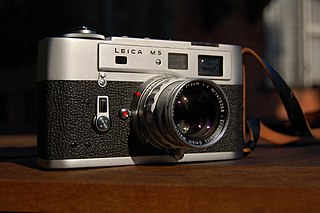
The Leica M5 is a 35 mm camera by Leica Camera AG, introduced in 1971. It was the first Leica rangefinder camera to feature through-the-lens (TTL) metering and the last to be made entirely in Wetzlar by hand using the traditional "adjust and fit" method.
This article discusses the cameras – mainly 35 mm SLRs – manufactured by Pentax Ricoh Imaging Corp. and its predecessors, Pentax Corporation and Asahi Optical Co., Ltd.. Pentax must not be confused with Pentax 6x7 or Pentax 67 which are 120 medium format 6x7cm film cameras.
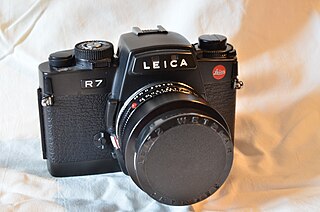
Leica R4, R5, R6, R7 were 35 mm SLR cameras manufactured by Leica between 1980 and 1997 and belonged to the manual focusing R-System, which was offered from 1965 to 2009.
Zuiko is a brand of optical lenses made by Olympus Corporation that was used up to and into the Four Thirds system era. The name Zuiko (瑞光) means 'Light of the Gods', using a character from the Mizuho Optic Research Laboratory (瑞穂光学研究所), where the lens was developed, and a character from Takachiho Corporation (高千穂製作所), which would eventually become the Olympus Corporation.
















